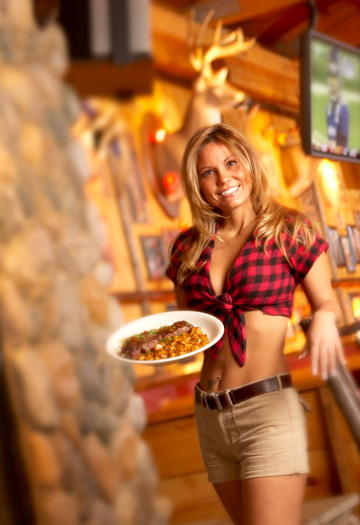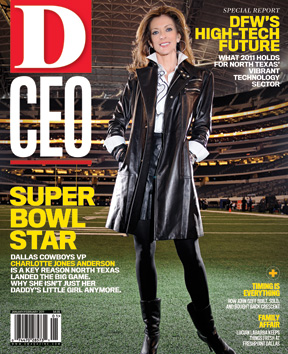Don’t tell the owners of Addison-based restaurant chain Twin Peaks that imitation is the sincerest form of flattery. Its parent company, Twin Restaurant IP LLC, filed a lawsuit in November in the U.S. District Court for the Northern District of Texas (Dallas Division) against a would-be competitor in Arkansas. Twin Peaks’ ownership claims that entrepreneur Kevin Laughlin and his company, Grand Tetons LLC, are poised to open Northern Exposure in Fayetteville, Ark., and that the restaurant infringes on Twin Peaks’ trademarks and “trade dress”: namely, their double-entendre-laden name and slogan, their wilderness lodge-themed décor, and, of course, their scantily-clad female servers outfitted in low-cut plaid tops and short shorts.
The stakes are potentially high. At a time when other chain restaurants are struggling, the so-called “breastaurants” have been seemingly recession-proof. In 2008 Hooters reported chainwide sales of $997 million, a 2 percent increase from the previous year. Twin Peaks, started in 2005 by Rockfish founder Randy Dewitt, already has nine Texas locations and one each in Oklahoma and New Mexico, with additional restaurants set to open in Southlake, Houston, Oklahoma City, Arkansas, and Nebraska. Nation’s Restaurant News reported that the chain had system-wide sales of $33 million, with the typical site generating annual sales of $3 million. Other competitors, such as Bone Daddy’s and the Tempe, Ariz.-based Tilted Kilt, have also been expanding.
According to allegations in the lawsuit filed by attorney John L. Hendricks, of the Dallas law firm Hitchcock Evert LLP, this is not simply a case of a corporate Goliath flexing its muscle against a David with a similar concept. Twin Peaks claims that in the spring of 2009, Laughlin actually filed an application to become a Twin Peaks franchisee and visited Dallas to meet with the chain’s executives. While in town, the suit says, Laughlin was given a tour of a Twin Peaks location in Plano and was “made privy to Twin Restaurant’s knowledge and expertise concerning recruiting, training, motivating, and retaining a staff.” Twin Peaks also claims that it steered Laughlin away from the notion of opening a Twin Peaks in the family-oriented resort area of Branson, Mo., in favor of Fayetteville, with its college-town atmosphere and proximity to such corporate headquarters as Wal-Mart Stores Inc. and Tyson Foods Inc.. In fact, Twin Peaks maintains that it even suggested a particular building in Fayetteville, assisted Laughlin in negotiating a good price for the property; provided an architect, general contractors, and kitchen and bar designer for visits to Fayetteville to help with remodeling the building; and even sent a Twin Peaks executive to Fayetteville to facilitate introductions to local distributors and contractors.
Despite all of this, Twin Peaks alleges, Laughlin later informed them “that he no longer wished to operate a Twin Peaks Restaurant and that, if he opened any restaurant at the Property, it would be a different concept.”
After Twin Peaks moved forward with another franchisee for Fayetteville, the chain learned that in July 2009 Laughlin had incorporated the entity Grand Tetons LLC doing business as Northern Exposure—names that Twin Peaks contends are innuendos patterned after its own. In October, its new franchisee spotted signs for Northern Exposure—signs that featured a similar slogan promising “scenic views,” an illustration of two snowcapped mountains, as well as a depiction of a woman wearing clothing similar to the uniform of a Twin Peaks server. Although Northern Exposure had not yet opened as of the lawsuit’s filing, Twin Peaks claims that “upon information and belief,” the upstart restaurant’s servers will be similarly attired to their Twin Peaks counterparts, and that “the look and feel of the interior of the property” will evoke a “substantially similar” northern wilderness lodge vibe.
The lawsuit seeks an injunction against the defendants’ use of any of the plaintiff’s intellectual property (including trade dress), destruction of any advertising or packaging that infringes on Twin Peaks’ trademarks, and any profits resulting from the alleged infringement, as well as attorneys’ fees and other unspecified damages. At press time, Laughlin and his company had not yet filed a response to the lawsuit and its allegations.
What exactly is trade dress, though, and can you really have intellectual property protection for the feel or appearance of a restaurant? As a matter of fact, the concept of trade dress protects exactly that—the distinctive appearance of a business or product, including the distinctive packaging of a product, or even the interior design of a restaurant. The distinctive shape of an automobile like the Volkswagen Beetle can be protected trade dress, just like the shape of a Coca-Cola bottle, or the cowboy imagery used to promote a particular brand of cigarettes. Even sales and marketing techniques, like the use of “adoption papers” and “birth certificates” to sell Cabbage Patch dolls, can be protected trade dress when they help constitute the total image of a business.
LIMITS TO PROTECTION
Restaurants have been successful in obtaining trade dress protection for the interior and exterior appearance of their buildings, thanks primarily to a landmark U.S. Supreme Court decision in 1992. In Two Pesos Inc. v. Taco Cabana, the court held that Taco Cabana’s distinctive trade dress—the shape and color scheme of its exterior, the décor, menu, signage, servers’ uniforms, and so on—that reflected its total image could be protected against another restaurant using confusingly similar design and décor elements. Since then, restaurant chains like Chipotle and Miami Subs have successfully registered their interior and/or exterior décor as trade dress.
But there are limits to trade dress protection. Besides proving that its own trade dress is inherently distinctive and that the purported knockoff is confusingly similar, Twin Peaks will have to show that its trade dress is primarily nonfunctional. That very factor tripped up the Hooters restaurant empire in a similar federal lawsuit in 2004 against regional rival Winghouse of Florida Inc. Hooters had argued that its “Hooter Girl” uniform of tank top and running shorts and “beach shack” interior décor were protected trade dress. The 11th U.S. Circuit Court of Appeals disagreed, pointing out that the décor and design elements of the competing chain were sufficiently different, and that the “Hooters Girl” look was predominantly functional—that function being “to titillate, entice, and arouse male customers’ fantasies. She is the very essence of Hooters’ business,” according to the court.
Based on this, Twin Peaks may have to scale new legal heights. Although both restaurants may rely on waitresses in red and black plaid tops serving up food, drink, and sex appeal in a mountain lodge-like environment, that evocative lodge décor has appeared in other restaurants and may be viewed as generic. And if even the iconic Hooters’ uniform didn’t merit trade dress protection because of its functionality, it’s difficult to imagine a court regarding the Twin Peaks attire any differently.
Still, successful trade dress claims rise and fall on the overall feel and appearance of the business. In this “battle of the breastaurants,” there probably won’t be any shortage of volunteers willing to conduct the necessary on-site research.
John Browning is a partner at the law firm of Thompson Coe Cousins & Irons in Dallas, an award-winning journalist, and the author of The Lawyer’s Guide to Social Networking.






